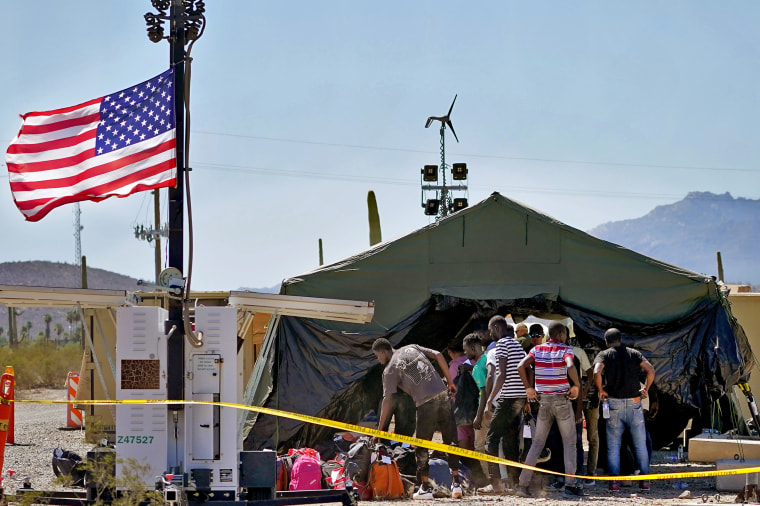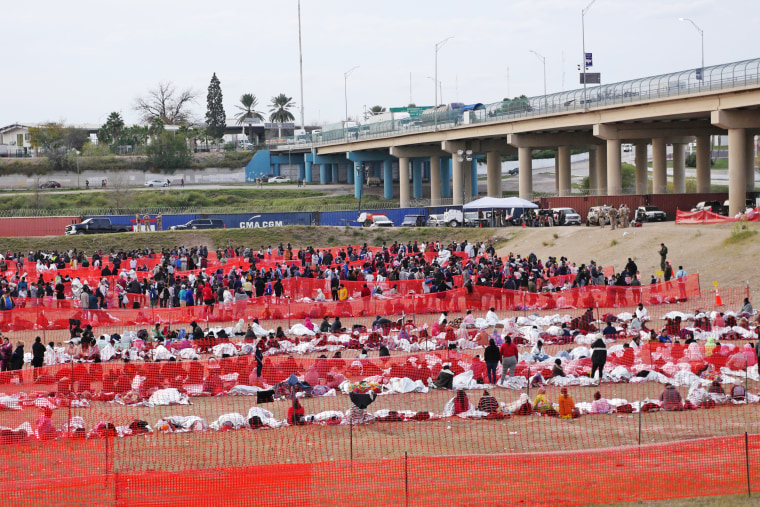U.S. border facilities have a record number of migrants in custody as border agents try to release migrants as fast as possible to avoid overcrowding and local nonprofit groups scramble to keep up with the need, according to three Department of Homeland Security officials.
Many migrants in Arizona's Tucson sector, one of the busiest, are being released directly onto the streets, according to two DHS officials.
The officials said the migrants are dropped off in coordination with the city officials and local nonprofits who help them get transportation to their final destinations.
On Wednesday, U.S. Customs and Border Protection encountered more than 12,000 undocumented migrants crossing the border for the third straight day, a new record. And approximately 27,000 migrants were in CBP custody as of Wednesday night, another record, with more arriving and more being released into the United States by the hour.
In the region surrounding Tucson, CBP processing centers are often at double their capacity. The two Homeland Security officials told NBC News that Border Patrol agents are dropping off busloads of migrants every half-hour in downtown Nogales, Arizona, to alleviate crowding in processing centers.
From there, the migrants are typically assisted by a local nongovernmental organization, most often Casa Alitas, which told NBC News that it is seeing a record number of migrants in its shelters and added pressure to help provide transportation elsewhere.

“It’s an extra burden that we’ve all had to lift, making sure that people were not left an hour or two hours away from an airport or major travel hub,” Casa Alitas Director Diego Lopez said.
Lopez and his staff help migrants book travel to the interior of the U.S. But he says his organization’s resources are running thin. Casa Alitas used to provide things like toys and teddy bears to migrant children, but has had to stop since it now shelters more than 10,000 migrants per week.
“We can only focus on helping support people with a meal, clothing and helping people move on to their sponsors,” he said. “The last few months, as a shelter, we have been breaking records week to week.”
Further east, in the border region encompassing Eagle Pass, Texas, hundreds of migrants are amassed under a bridge, and federal facilities are at almost three times their capacity. Border Patrol officials in that sector are using more than 40 buses per day to send migrants from that area to other parts of the Texas border to alleviate overcrowding.
Thousands of migrants wait in the field for CBP to bring them to a processing center, but the sector has so far not released migrants onto the streets.
Despite the high numbers, migrants are still being released in under 72 hours, the court-mandated limit for how long they can stay in CBP processing centers. From there, a small number of migrants may be taken to Immigration and Customs Enforcement, but most are released.

The strain has actually proven the efficiency of new technologies that let CBP quickly screen migrants for potential medical conditions or national security threats and then release them. Previous migrant surges, such as in 2019, had left migrants in inhumane conditions. Some weren’t able to lie down to sleep in CBP processing centers.
All of those currently being released by CBP have court dates and locations where they must appear for their immigration hearings, the three Homeland Security officials said. Earlier this year, to alleviate overcrowding, CBP began releasing migrants without court dates and with only a notice to report to an ICE office. The Biden administration has since been blocked by courts from using that practice.
The head of CBP, Troy Miller, is asking Congress for more money to help his agency handle the record numbers.
“The encounter levels we are currently seeing across the southwest border are presenting a serious challenge to the men and women of CBP,” said Miller, the senior official performing the duties of the commissioner, as he is not Senate-confirmed to the position. “CBP and our federal partners need additional funding from Congress so that we can continue to effectuate consequences for those who do not use the established pathways.”
Meanwhile, Senate negotiations that could ultimately deliver more funding to CBP remain unresolved as many lawmakers head home ahead of the Christmas holidays.

